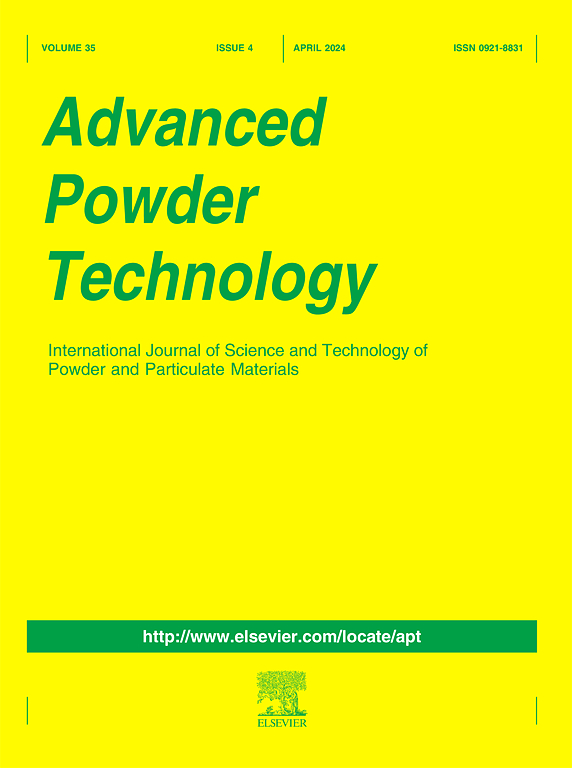The assessment of the influence of interaction forces on heat transfer and pressure drop using Eulerian-Lagrangian model with various particle collision approaches
IF 4.2
2区 工程技术
Q2 ENGINEERING, CHEMICAL
引用次数: 0
Abstract
This study investigates the impact of critical forces—including linear and rotational drag, gravity, Saffman’s lift, thermophoretic, Brownian, virtual mass, Magnus, pressure, and particle collisions—on pressure drop and the average wall Nusselt number in particle-laden flows using a validated Eulerian-Lagrangian model. The analysis covers a particle Reynolds number range of and evaluates four particle interaction models: linear spring, spring-dashpot, Hertzian, and Hertzian-dashpot. Model validation is conducted against benchmark cases, including particle sedimentation, the Segre-Silberberg effect, drafting-kissing-tumbling, Brownian motion (assessed via mean square displacement and diffusion profiles), and the transient thermal response of spherical particles. Heavy (2702 kg/m3) and light particles (500 kg/m3) are studied under gravity directed downward (horizontal channel) and against the flow (vertical channel). The findings reveal that linear and rotational drag are the primary contributors to pressure drop, with their omission resulting in increased Nusselt numbers across all scenarios. Excluding other forces, particularly Saffman’s lift and Magnus, causes moderate reductions in the Nusselt number. The study advocates for the use of spring-dashpot and Hertzian-dashpot models at higher mass flow rates to capture energy dissipation accurately, preventing Nusselt number overestimations of 0.54 %–1.1 % for particle mass flow rates between 0.01 and 0.1 g/s.

用欧拉-拉格朗日模型和不同粒子碰撞方法评估相互作用力对传热和压降的影响
本研究使用验证过的欧拉-拉格朗日模型,研究了临界力(包括线性和旋转阻力、重力、Saffman升力、热热、布朗、虚质量、马格努斯、压力和粒子碰撞)对微粒流中压降和平均壁面努塞尔数的影响。该分析涵盖了0.4<Rep<;1.75的粒子雷诺数范围,并评估了四种粒子相互作用模型:线性弹簧,弹簧-dashpot,赫兹和赫兹-dashpot。模型验证是针对基准情况进行的,包括颗粒沉降、西格雷-希尔伯格效应、牵伸-亲吻-翻滚、布朗运动(通过均方位移和扩散曲线评估)以及球形颗粒的瞬态热响应。重颗粒(2702 kg/m3)和轻颗粒(500 kg/m3)在重力向下(水平通道)和反流(垂直通道)的情况下进行了研究。研究结果表明,线性和旋转阻力是造成压降的主要因素,在所有情况下,忽略它们会导致Nusselt数增加。排除其他力量,特别是萨弗曼的升力和马格努斯,会导致努塞尔数的适度减少。该研究提倡在较高的质量流率下使用弹簧-阻尼器和赫兹-阻尼器模型来准确地捕捉能量耗散,防止在颗粒质量流率为0.01和0.1 g/s之间的努塞尔数高估0.54% - 1.1%。
本文章由计算机程序翻译,如有差异,请以英文原文为准。
求助全文
约1分钟内获得全文
求助全文
来源期刊

Advanced Powder Technology
工程技术-工程:化工
CiteScore
9.50
自引率
7.70%
发文量
424
审稿时长
55 days
期刊介绍:
The aim of Advanced Powder Technology is to meet the demand for an international journal that integrates all aspects of science and technology research on powder and particulate materials. The journal fulfills this purpose by publishing original research papers, rapid communications, reviews, and translated articles by prominent researchers worldwide.
The editorial work of Advanced Powder Technology, which was founded as the International Journal of the Society of Powder Technology, Japan, is now shared by distinguished board members, who operate in a unique framework designed to respond to the increasing global demand for articles on not only powder and particles, but also on various materials produced from them.
Advanced Powder Technology covers various areas, but a discussion of powder and particles is required in articles. Topics include: Production of powder and particulate materials in gases and liquids(nanoparticles, fine ceramics, pharmaceuticals, novel functional materials, etc.); Aerosol and colloidal processing; Powder and particle characterization; Dynamics and phenomena; Calculation and simulation (CFD, DEM, Monte Carlo method, population balance, etc.); Measurement and control of powder processes; Particle modification; Comminution; Powder handling and operations (storage, transport, granulation, separation, fluidization, etc.)
 求助内容:
求助内容: 应助结果提醒方式:
应助结果提醒方式:


